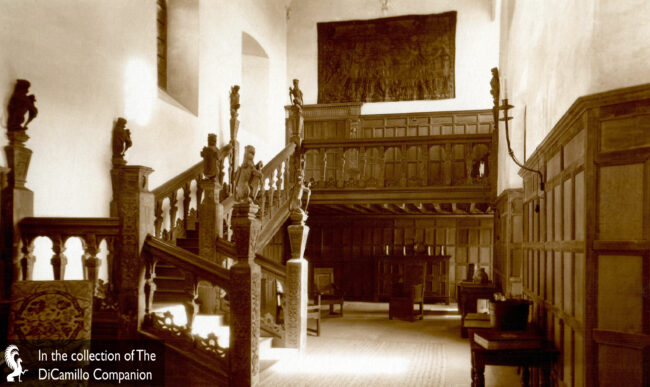
The Great Staircase (oak) from Theobalds Palace (today at Herstmonceux Castle). From a circa 1914 postcard.
Built / Designed For: William Cecil, 1st Lord Burghley
House & Family History: The manor of Theobalds had a number of earlier names: Cullynges, Tongs, Thebaudes, Tibbolds, and finally Theobalds. Originally surrounded by a moat, the 16th century house was begun in 1564 (enlarged and remodeled in the 1570s) for William Cecil, Queen Elizabeth I's virtual prime minister (the actual office of prime minister wasn't created until the 18th century). The queen favored Cecil, later 1st Lord Burghley, with eight visits to Theobalds between 1572 and 1596. In a now-famous incident, King James I was so taken by Theobalds during his first visit to the house that he persuaded Robert Cecil (his virtual prime minister and William's son) to exchange it for the Palace of Hatfield. Theobalds was virtually demolished during the Commonwealth and, though it was rebuilt after the Restoration, the palace never recovered its past magnificence and was eventually demolished. Circa 1765-70, on a site very close to the former Theobalds, four small country houses (Old Palace House, The Cedars, Cecil House, and Jackson's School) were built in an area known as Theobalds Square; none of these survive today. The only remaining bit of Theobalds Palace that still stands is a window and one strip of brickwork with stone quoins, 15th feet high, now part of the gardener's cottage of Old Palace House. What is believed to have been the great staircase from Theobalds Palace (see "Images" section) was, at one time, installed at Theobalds Park (since the early 20th century the staircase has been installed at Herstmonceux Castle). The current Theobalds Park [qv], today a conference center and hotel, was the home of the Victorian brewing magnate Sir Henry Meux.
Garden & Outbuildings: The formal gardens of William Cecil's Theobalds were modeled after the gardens of the Château de Fontainebleau by Cecil's head gardener, John Gerard. James I enlarged the park and, in 1620, enclosed the estate with a brick wall nine-and-a-half miles long, fragments of which survive today. The stableblock and the Banqueting House, both designed by Inigo Jones for James I, were demolished during the Commonwealth (circa 1650).
Architect: Inigo Jones
Date: 1623-25
Title: Buildings of England: Hertfordshire, The
Author: Pevsner, Nikolaus; Cherry, Bridget
Year Published: 2000
Publisher: London: Penguin Books
ISBN: 0140710078
Book Type: Hardback
Title: Biographical Dictionary of British Architects, 1600-1840, A - HARDBACK
Author: Colvin, Howard
Year Published: 2008
Reference: pg. 590
Publisher: New Haven: Yale University Press
ISBN: 9780300125085
Book Type: Hardback
House Listed: Demolished
Park Listed: Not Listed
Past Seat / Home of: William Cecil, 1st Baron Burghley, 16th century; Robert Cecil, 1st Earl of Salisbury, early 17th century. King James I, early 17th century. George Monck, 1st Duke of Albemarle, 17th century. William Bentinck, 1st Earl of Portland, late 17th century.
Current Ownership Type: Demolished
Primary Current Ownership Use: Demolished
House Open to Public: No
Historic Houses Member: No